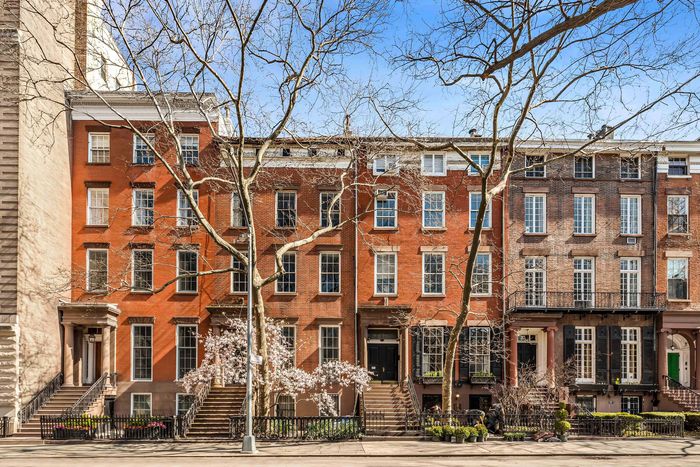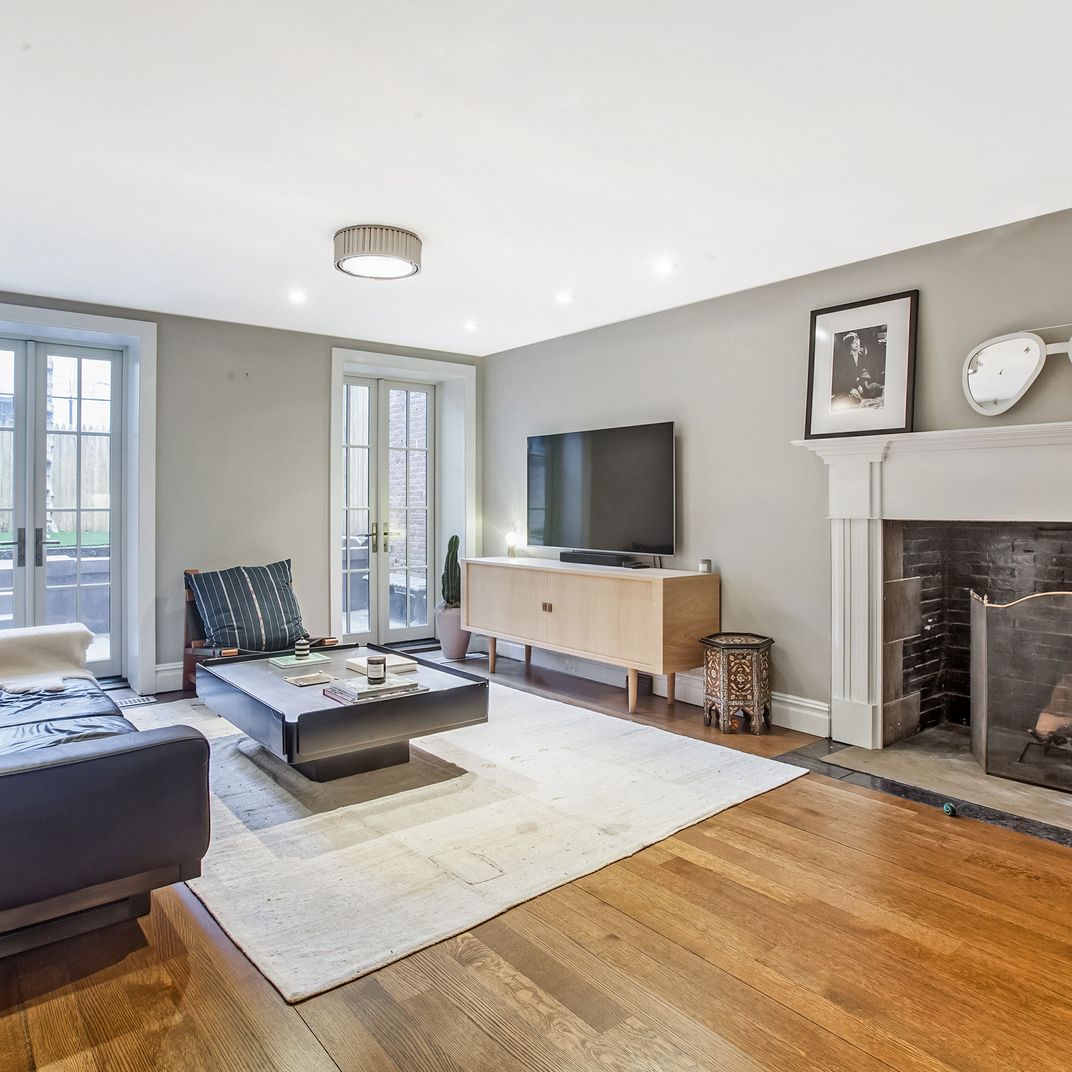
You can’t cross Washington Square to buy a joint or smoke a joint or sell a joint without wondering who may be watching from the stately townhomes along the park’s north edge. Built together in the 1830s and nicknamed “the Row” for their unified fronts — all brick, all Greek Revival, and all stodgy — they sit serene and out of reach. Snapped up over the years by NYU, only four are owned by mere civilians. Last week, one of them went up for sale.
26 Washington Square North is the farthest west, hooked in the shadow of the seven-story apartment building that fronts MacDougal. It’s the only home on the Row with an extra, fifth story — added before preservation battles were a thing — which is yet another reason that buying this is “certainly a rare opportunity and unlikely that one will be coming up again in the near future,” said broker Fred Williams, who has the listing at Sotheby’s International Realty with agent Torsten Krines. “I think of the Row as the equivalent of the Painted Ladies on Alamo Square in San Francisco,” says Andrew Berman, executive director of Village Preservation, an advocacy group. “They were, in their time, the most prestigious row of houses in New York City.”
To Henry James, living on the Row at the end of the 19th century was the height of good taste. (James himself was never lucky enough — living slightly out of reach on Washington Square East.) His 1880 novel Washington Square is set in a Row house and breaks POV to allow a “topographical parenthesis” on the Row’s “established repose which is not of frequent occurrence in other quarters of the long, shrill city … the look of having had something of a social history.” Edith Wharton, who lived on the Row two years later, watched that social history disappear as rich families fled uptown. A new-money matriarch in her 1913 novel Custom of the Country wonders why anyone would choose to live “way down there,” while her daughter’s old-money fiancé — a failed poet who leans on her for cash — finds it clever to refer to the Row as “the Reservation,” home to “those vanishing denizens of the American continent, doomed to rapid extinction.”
The “vanishing denizens” of number 26 are the Morgans, who occupied the home for 50 years after the Civil War. William Dare Morgan, the son of a successful captain, and the one who bought the home with his wife, had spent time in London, where he managed to befriend Charles Dickens, who so admired Morgan that he entrusted a son testing out adventure to Morgan’s care — the pre-NYU loco parentis. Morgan was a businessman who had married into two rich families via Angelica Livingston Hoyt (that Livingston, that Hoyt), and even by 1909, the house had enough servants to make a headline over a spat between them.
At some point the last of the Morgans absconded, and 26 was chopped into apartments, as Washington Square was on its way to becoming a bohemian den, a protest zone, and, finally, a college campus — a wild retirement for a public space that began as a potter’s field and a military practice ground. A varying cast of bohemian tenants included the painter Everett Shinn, whose paintings and pastels depicted the park over and over again.
Now the listing could pull the house back to its original status as a mansion for a single owner. It’s still configured as apartments; there are five, each occupying a single floor, and they’ve been renting for more than $10,000 a month, thanks in part to a slick renovation in 2018 carried out by the current owner, Williams says. (That buyer is anonymous, having purchased with an LLC in 2001.*) The next owner could keep the building as is, or convert its ten bedrooms, 13 bathrooms, five kitchens, ten fireplaces, and the original twisting staircase into a single mansion, almost exactly like the Morgans had it. The apartments have high ceilings, and the parlor floor even includes built-in bookshelves, reached via a rolling library ladder. There’s outdoor space aplenty: a walled backyard, a roof with views, and a front garden with an original ironwork fence whose finials mimic pinecones.
Even if Washington Square Park has seen its share of tabloid coverage, it’s still a grand address. Shinn, the artist tenant, wrote in 1911 that he considered the park to be the city’s most beautiful spot, whether you were behind the glass and looking out, or smoking a joint and wondering who lived inside: “No matter what the conditions may be under which I see it — no matter what my mood may be — I feel almost sure that it will appeal to me as beautiful.”
*Updated 10:08 am: The article originally stated that the owner bought in 2017. It has since been corrected to state that the owner bought in 2001.
26 Washington Square Park North is also referred to as the William Dare Morgan house for the patriarch of the family that occupied it for 50 years after the Civil War.
The view from 26. Painter Everett Shinn, who lived here after the Morgans left, described the park as his favorite view in New York City: “No matter what the conditions may be under which I see it — no matter what my mood may be — I feel almost sure that it will appeal to me as beautiful.”
The unit on the parlor floor includes an original fireplace and bookshelves.
The building is now configured as five separate luxury apartments, renovated in 2018 with nostalgia for the home’s 19th-century origins.
Each of the five units includes two fireplaces, one in a front living area and one in a back bedroom.
Each apartment has been listed for rent above $10,000, but the units could be combined into a single home.
A walled backyard. Past the fence, a carriage house on MacDougal Alley was once a part of this same home.
Each of the apartments has hardwood floors and park views.
26 Washington Square Park North is also referred to as the William Dare Morgan house for the patriarch of the family that occupied it for 50 years after the Civil War.
The view from 26. Painter Everett Shinn, who lived here after the Morgans left, described the park as his favorite view in New York City: “No matter what the conditions may be under which I see it — no matter what my mood may be — I feel almost sure that it will appeal to me as beautiful.”
The unit on the parlor floor includes an original fireplace and bookshelves.
The building is now configured as five separate luxury apartments, renovated in 2018 with nostalgia for the home’s 19th-century origins.
Each of the five units includes two fireplaces, one in a front living area and one in a back bedroom.
Each apartment has been listed for rent above $10,000, but the units could be combined into a single home.
A walled backyard. Past the fence, a carriage house on MacDougal Alley was once a part of this same home.
Each of the apartments has hardwood floors and park views.












